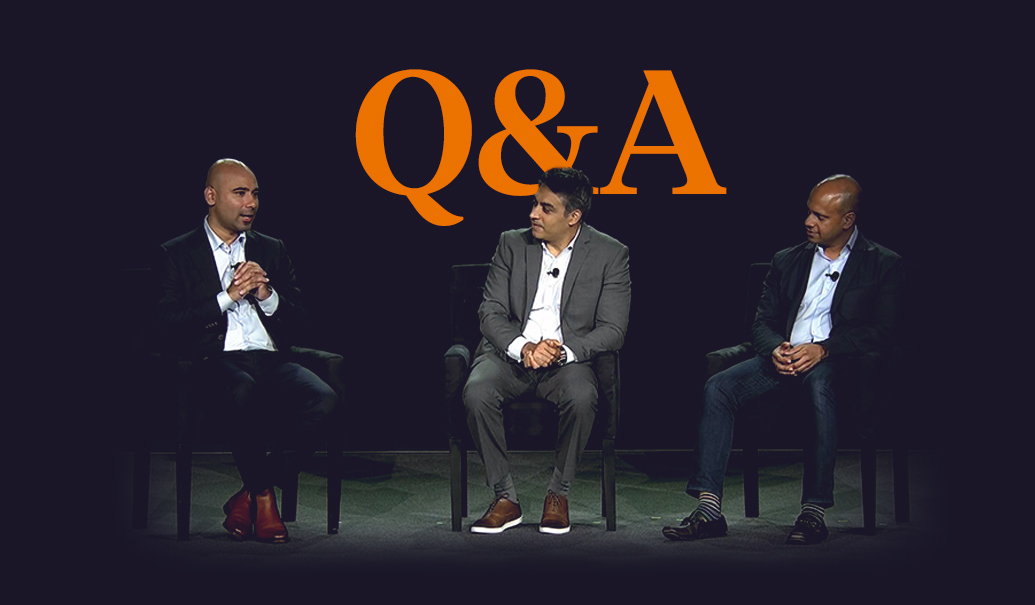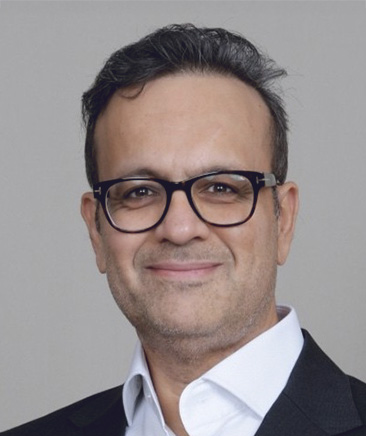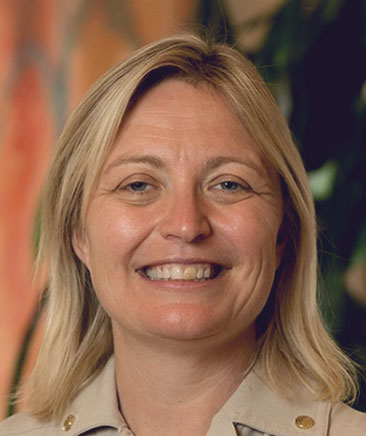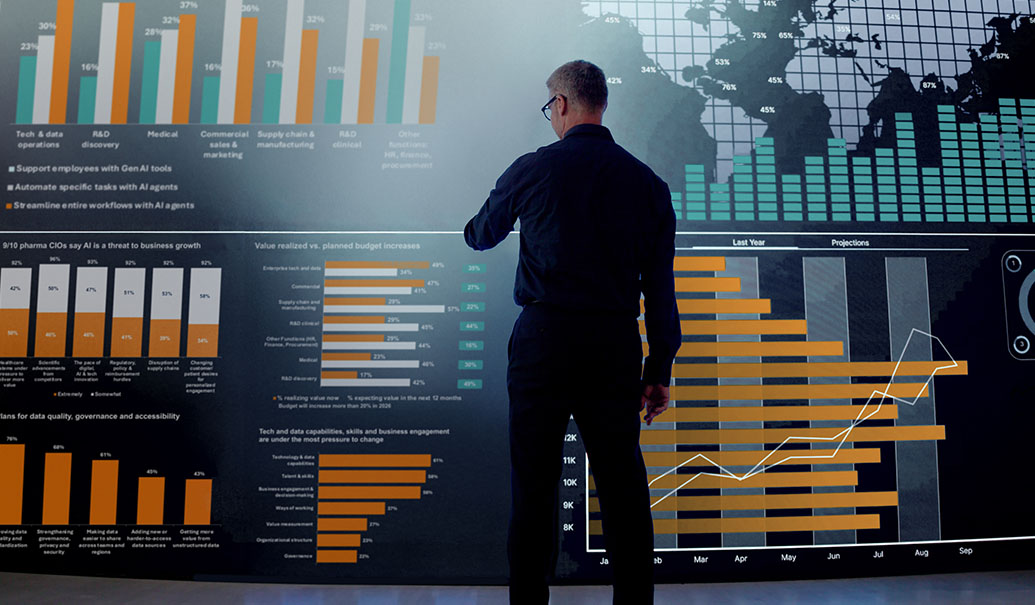In this panel discussion, three industry experts joined ZS to discuss what they’re doing to drive digital transformation. Together, they lead in ways that tie digital investments directly to business and patient outcomes.
Samer Ansari, head of data, digital and technology at Takeda Oncology, Ajit Menon, Janssen vice president of customer engagement and digital transformation and Deepak Nair, director of Amazon Web Services’ healthcare and life sciences business, joined the conversation.
ZS: In a recent ZS survey, less than half of pharmaceutical executives said they believe their company generates value they expected from their digital initiatives. What do you do to ensure the value of your initiatives is understood?
Samer Ansari, Takeda Oncology: The more we can be clear in terms of outcomes we’re trying to create for the patient or the business, the easier it becomes to define what digital can do to enable it. At Takeda Oncology, we work to identify value from a patient and business outcome perspective and then think about the specific capability, use case or idea that can scale and be brought to life for our patients and our customers in very tangible ways. So, I think the trick I’ve learned is to be clear in what you’re trying to do and make sure that it’s not very open-ended.
Ajit Menon, Janssen: And I’ll add that value needs to be articulated against your strategic choices. Those choices must be relative to the scale you’re trying to achieve, and you need to continually reinforce why you’re making the choices you’re making. So, to Samer’s point, there’s a need to define value from a customer standpoint. Investments need to be very specific and shared in the context of strategic choices, and those messages must be continually reinforced along the way.
ZS: The traditional pharma operating model is centered around how medicine development happens—taking something from R&D through trials and then commercializing it, whereas digital native companies operate very differently. Can you talk about why the operating model is an area of focus when scaling digital value?
Deepak Nair, AWS: I want to be careful that I don’t externalize what happens at Amazon because the things we do aren’t easily applied elsewhere, but Ajit and Samer both referred to looking backward from the customer. Yet when I look at pharma, many architectures are designed based on organizational structures versus, “Hey, how do I support the customer? How do I support drug discovery?” And I think unless we start getting into that operating model piece of how these teams are structured and how they deliver solutions to the market, it gets very hard to implement digital on an enterprise scale.
Ajit Menon, Janssen: When I think about the operating model question, I think there’s definitely room to evolve. Are we organized at scale to assemble teams, work on projects, disband and then go on to other projects and other use cases? We saw this during the pandemic when we brought together self-organizing, cross-functional teams to solve specific problems. We need to continue pushing this because the idea is critical to the success of pharmaceuticals and life sciences.
Deepak Nair, AWS: True, how we construct teams is different. Our organizational structure is derived from how we think about the teams we need to support the customer, not the other way around.
Samer Ansari, Takeda Oncology: I’ll build on this. We’ve moved from a central enterprise function for digital and technology toward a model where these teams sit under every business unit. And since then, we’ve seen the investment in digital and technology increase exponentially because the P&L owner can make the right tradeoffs relative to other business decisions.
An interesting side of this, though, is the teaming—our data, digital and technology teams work in agile ways, but other functions within any given business unit may not be set up as agile and product-centric teams. We do see good similarities with R&D because they’re already set up in a way for agile science, so they often have similar instincts.
In this model, we ask: How do we create a cultural movement within the intersection of these traditional and digital teams to make sure that those functions, regardless of their silos, drop the fences and work toward that common idea? So, you’ve got to focus on and celebrate the interfaces and bring anyone already digitally wired along with you in your successes. To do this, you need an environment where people feel secure and they feel empowered to contribute, and success is celebrated. I think that’s the key.
Ajit Menon, Janssen: And that’s extremely important. We need those programs, those curricula where we upskill our marketers, our sales folks, our technology folks, our commercial folks and our operations teams on an ongoing basis and cross-functionally train people to help us continually grow digital skills.
ZS: Our broader theme today has been about the disconnects across healthcare and how we create a more connected ecosystem. What about this notion of disconnects and any advice for others?
Deepak Nair, AWS: I’m oversimplifying this, but in our business, unless you can understand data, it’s tough to understand what the customer wants to stock fulfillment centers and deliver something within two hours. And to me, data is the foundation of connectivity within any ecosystem. Customer experience is how we do everything, but teams having access to data to do their work is a big part of it.
Samer Ansari, Takeda Oncology: When you have an idea, you’ve got to bring in your experts early to evaluate how connected it is. How will it work with your existing internal and external ecosystem? Then, it’s essential to pause and think about build, partner or acquisition strategy. Digital is connected, so it’s about figuring out in a smart way, what the outcome you’re trying to achieve is and working from there. But you need to consider the broader ecosystem to get the outcome you need.
Part of our philosophy for this, for example, for patients or customers, is to meet them where they already are versus creating our island and expecting them to join us. So, you’ve got to be humble. You’ve got to be self-aware and figure out where they are and what they expect.
Ajit Menon, Janssen: Back to an earlier question that you had about scale, the biggest impediment to scale is that connected user experience, that last-mile delivery. Amazon, Domino’s, these examples from outside the pharma and life sciences industry are pretty telling. So, I think if we could focus on those things and innovating those continually, learning and innovating, I think that’s where we’ll see the value.
Add insights to your inbox
We’ll send you content you’ll want to read – and put to use.















